젖꼭지가 아프거나 갈라질 때, Painful nipple and nipple fissures
- 수유모의 젖꼭지가 아프거나 갈라져 많이 고생할 수 있다.
- 젖을 먹는 아기가 젖꼭지를 입안에 넣고 늘어지면 젖꼭지가 아플 수 있다. 이때 젖꼭지에 어떤 외상은 생기지 않고 아프기기만 하는 것이 보통이다 .
- 젖꼭지가 아프게 하는 흔한 원인은 다음 같다. .
-
-
젖꼭지의 끝 부분에 상처가 생길 때
-
젖을 빨 때 젖꼭지를 물고 깨물 때
-
젖꼭지에 진균(곰팡이) 감염이 생길 때
-
피부염이나 접촉성 피부염이 젖꼭지에 있을 때
- 젖꼭지가 무엇으로 자극받아 헐었을 때,
- 젖꼭지의 아랫부분에 상처가 생겼을 때
- 젖꼭지에 진균 감염도 있고 젖꼭지가 자극받아 헐었을 때
- 그 외
-
다음 각 원인 별로 더 설명한다.
1. 젖꼭지 끝부분 상처로 젖꼭지가 아플 수 있다
Nipple pain caused nipple end injury
- 모유를 수유하는 중 아기의 위 입술과 아래 입술을 유륜에 바짝 대고 수유 하지 않고 젖꼭지만 아기의 입안에 물려 젖을 빨리면 젖꼭지의 끝 부분에 상처가 나기 쉽고 그로 인해 젖꼭지가 아플 수 있다.
- 이렇게 젖꼭지가 아픈 것을 유두통(Nipple soreness)이라 한다.
- 젖 먹는 아기의 위아래 입술을 유륜(유두륜/젖꽃판)에 바짝 대고 아기가 젖꼭지와 유륜을 함께 빨 수 있게 아기의 몸을 수유모의 앞가슴에 바짝 당겨 앉고 젖을 먹여야 젖꼭지의 끝 부분에 상처가 생기지 않는다.
- 수유모가 뒤로 비스듬하게 앉은 자세로 수유 할 때 젖꼭지 끝 부분이 아기의 입천장에 밀착되고 마찰될 때 젖꼭지 끝 부분이 손상될 수 있다.
- 젖꼭지의 끝 부분에 상처가 생기면 젖꼭지가 몹시 아프고 거기에 딱지가 지고 갈라지고 물집이 생길 수 있다.
- 젖을 먹이기 전 손이나 젖 짜는 펌프(유축기)로 젖을 조금 짜내면 젖꼭지와 유륜이 더 부드럽게 되고 아기가 젖꼭지와 유륜을 함께 입안에 넣고 젖을 쉽게 빨 수 있다. 이렇게 수유 하면 젖이 더 쉽게 나고 젖꼭지의 끝 부분에 상처가 잘 생기지 않는다.
- 젖꼭지에 진균 감염병이 생기든지 박테리아 감염병이 생기면 젖꼭지가 아플 수 있다.
- 접촉성 피부염이나 알레르기성 피부염이 젖꼭지에 생길 때 젖꼭지가 아플 수 있다.
- 젖꼭지에 외상이 생기면 젖꼭지가 아플 수 있고 젖꼭지에 감염병이 있으면 젖꼭지 통증이 생길 수 있다.
- 젖꼭지가 아프면 타이레놀이나 모트린 등 경구용 진통제로 젖꼭지 통증을 치료할 수 있다.
- 더운 물찜질로 치료할 수 있다.
- 의사의 검진과 진단 치료가 필요할 때도 있다.
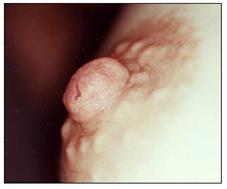
사진 4-136. 젖꼭지가 이렇게 조금만 갈라져도 몹시 아플 수 있다.
Copyright ⓒ 2011 John Sangwon Lee, MD, FAAP

그림 4-29. 갈라진 젖꼭지. 젖꼭지의 아래 부분도 가라질 수 있고 그로 인해 젖꼭지가 몹시 아플 수 있다.
Copyright ⓒ 2011 John Sangwon Lee, MD, FAAP
2. 젖꼭지 아래에 생긴 상처로 젖꼭지가 아플 수 있다
Injury of the lower portion of the breast nipple
- 입안으로 말려 들어간 아기 아랫입술로 젖꼭지를 빨 때 젖꼭지의 아랫부분에 상처가 생길 수 있고 그로 인해 젖꼭지의 아랫부분이 아플 수 있다.
- 아기가 젖꼭지를 빠는 동안 아기의 아래 입술이 입안으로 말려 들어간 입술로 젖꼭지를 빨 때는 젖꼭지를 아기의 입 안에서 즉시 빼야 한다.
- 만일 그런 상태로 젖꼭지를 계속 빨면 젖꼭지의 아래 부분에 상처가 계속 될 수 있고 그 정도가 더 할 수 있다.
- 라노린 크림을 젖꼭지 끝 부위에는 바르지 말고 아픈 젖꼭지 부분에만 발라 젖꼭지를 부드럽게 처치한다.
- 젖을 빨 때 아기의 입술, 특히 아래 입술이 아기의 입안으로 말려들어가지 않도록 아기의 입술을 손가락으로 밀어 입을 적절히 벌리고 젖꼭지를 아기의 입안에 적절히 물리고 젖꼭지를 다시 빨아먹도록 훈련시킨다.
- 젖꼭지에 외상이 생겨 아픈지 감염병이 생겨 젖꼭지가 아픈지 감별 한다.
- 그 원인에 따라 적절히 치료한다.
- 젖꼭지가 아플 때는 타이레놀이나 모트린 등 경구용 진통제로 대증 치료한다. (그 예방 대책과 치료 참조)
3. 모유수유 중 아기가 젖꼭지를 물거나 깨물 때 젖꼭지가 아플 수 있다
When an infant bites or nibbles the nipple in breastfeeding
- 아직 유치가 나지 않은 신생아들이나 영아들은 젖을 먹다가 가끔 엄마의 젖꼭지를 잇몸으로 깨문다.
- 아기를 부적절한 자세로 안고 젖을 먹이면 아기가 엄마의 젖꼭지를 물 수 있다.
- 특히 아기의 위아래 입술을 유륜에 바짝 갖다 대지 않고 아기의 입으로 젖꼭지만 빨게 할 때, 혹은 아기가 입을 조금 벌린 채 젖꼭지를 빨게 할 때, 아기가 젖꼭지를 깨물고 늘어질 수 있다.
- 아기가 젖꼭지를 빨 때 아기의 혀가 아기의 아래 잇몸과 아래 이를 덮고 젖꼭지를 빨아 젖을 먹어야 젖꼭지가 물지 않는다. 그렇지 않을 때 젖꼭지가 더 물리게 된다.
- 이런 때는 엄마가 젖을 주기에 적절한 자세로 아기를 고쳐 안고, 아기의 입 안에 젖꼭지를 제대로 물린 다음, 아기를 엄마의 품에 더 바싹 끌어안고 눈길을 맞추며 젖을 먹이면 아기가 젖꼭지를 물지 않는다.
- 젖이 탱탱하게 불었을 때는 젖 먹이기 직전에 손이나 유축기로 젖을 조금 짜내면 젖꼭지와 유륜이 덜 탱탱해지고 좀 부드러워진다.
- 이 때 젖꼭지를 아기의 입 안에 넣고 위아래 입술이 유륜에 꼭 닿게 한 다음 젖꼭지를 빨게 하면 아기가 젖꼭지를 덜 깨물 수 있다.
- 아기의 위아래 잇몸을 유륜에 바짝 대고 아기가 젖꼭지를 빨 수 있도록 아기의 몸을 엄마의 앞가슴에 더 바짝 당겨 안고 젖을 먹인다.
- 수유모가 미식 풋볼 잡는 자세로 아기를 안고 수유 하면 도움 된다. 이때는 입을 적절히 벌리고 젖을 먹을 수 있을 때까지 기다렸다 수유를 시작한다.
- 모유수유를 성공적으로 했던 여성들이나 간호사, 모유수유 전문가, 모유수유 전문의, 모유수유 장려 상담원 등의 도움을 받아 모유수유를 옳게 하는 방법을 배우면 아기가 젖꼭지를 덜 물을 수 있다.
- 생후 4개월부터 돌이 될 때까지 아기에게는 적어도 한 개나 그 이상 여러 개의 젖니가 난다. 어떤 아기는 젖니가 날 때, 젖니가 난 이후, 수유가 다 끝날 무렵에 장난치고 싶을 때 젖을 먹다가 젖꼭지를 살금살금 물어보기도 하고 물고 당겨보기도 한다.
- 젖니가 날 때도 엄마의 젖꼭지를 물지만, 특히 젖니가 잘 나지 않을 때 젖꼭지를 더 잘 물 수 있다.
- 젖니가 날 때쯤 이로 장난치느라고 젖꼭지를 물 수 있다.
- 어떤 경우에는 젖꼭지가 상당히 아프다.
- 그런 식으로 2~3일 동안 젖꼭지를 물다가 자연적으로 그친다.
- 아기가 젖을 먹다가 젖꼭지를 무는 것은 아기가 모유 이외 다른 음식물을 깨물어 먹을 수 있다는 신호일 수 있다.
- 이때가 곧 이유를 시작할 수 있는 시기일지 모른다.
- 아기가 젖꼭지를 물면 엄마는 아기에게 “안 돼(No)”라고 명백하고 엄숙하게 말해야 한다.
- 말로만 안 된다고 전달하는 것이 아니라 얼굴표정으로도 “안 돼(No)”라고 강력하게 표현한 다음 젖꼭지를 아기의 입 속에서 바로 빼야 한다.
- 이렇게 행동으로 말로 안 된다고 표현하면 대부분의 아기들은 젖꼭지를 물면 엄마가 싫어한다는 것을 알고 엄마의 젖꼭지를 무는 버릇을 버린다.
- 생후 9개월이 지난 이후 아기가 젖을 먹다가 젖꼭지를 계속 심하게 물고 깨물 때는 젖을 떼도 좋다.

사진 4-137. 미식 풋볼을 잡는 식으로 아기를 안고 수유하는 엄마
Copyright ⓒ 2011 John Sangwon Lee, MD, FAAP
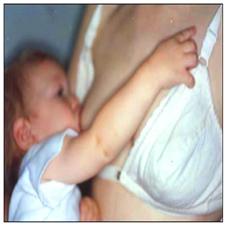
사진 4-138. 아기가 젖꼭지를 물고 당기고 야금야금 물면 물지 말라고 엄하게 말하면서 눈길로 주의를 줘야 한다.
Copyright ⓒ 2011 John Sangwon Lee, MD, FAAP
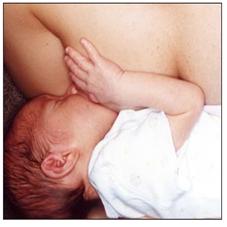
사진 4-139. 미식 풋볼을 잡는 자세로 아기를 안고 수유를 하면 젖꼭지를 덜 깨물 수 있다.
Copyright ⓒ 2011 John Sangwon Lee, MD, FAAP
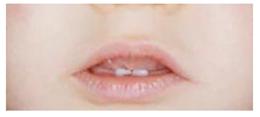
사진 4-140. 아래 잇몸에 젖니가 두 개 나있다.
Copyright ⓒ 2011 John Sangwon Lee, MD., FAAP
4. 젖꼭지 진균 감염병(젖꼭지 곰팡이 감염 병)
Monilial infection of nipples (A yeast infection of nipples)
- 모닐리아 진균 감염병이 젖꼭지에 생기면 젖꼭지가 붉고 붓고 만지면 아프고 갈라지고 가렵고 화끈거릴 수 있다.
- 하얗고 누런 딱지가 젖꼭지 끝에 붙어 있을 수 있다.
- 드물게는 수유 중 젖꼭지뿐만 아니라 유방 전체에 통증이 생긴다.
- 젖꼭지를 빠는 아기의 입 안에 모닐리아 진균이 동시 감염되어 아기 입에 아구창이 생길 수 있다.
- 젖꼭지 감염병은 경미한 한 것도 있다.
- 그 감염병의 정도에 따라 증상 징후가 다르다.
- 진균 감염병이 생긴 젖꼭지는 니스타틴 연고 등 항 곰팡이 국소 도포제로 치료할 수 있다.
- 젖 먹는 아기에게 생긴 아구창은 국소 니스타틴액제 드롭으로 치료한다.
- 수유를 한 후 브라를 입지 말고 젖꼭지와 유방을 공기에 노출시키면 더 잘 치료된다.
- 매번 수유를 한 후 깨끗한 수유용 패드를 브라 안에 넣어 젖꼭지 건강관리를 잘하는 것이 중요하다.
- 사용한 노리개 젖꼭지도 삶아서 살균하고, 사용한 유축기도 적절히 살균한 후 다시 사용한다.
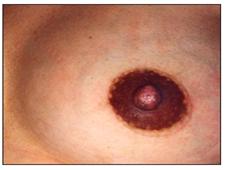
사진 4-141. 젖꼭지에 생긴 모닐리아 진균 감염
Copyright ⓒ 2011 John Sangwon Lee, MD., FAAP
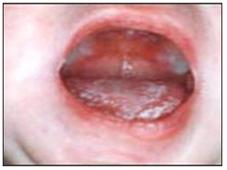
사진 4-142. 모닐리아 진균 감염으로 생긴 아구창이 아기의 입안에 생겨있다.
Copyright ⓒ 2011 John Sangwon Lee, MD., FAAP

사진 4-143. 퉁퉁 불은 유방과 젖꼭지.
유륜에 있는 오돌토돌한 돌기들은 몽고메리 돌기다.
Copyright ⓒ 2011 John Sangwon Lee, MD., FAAP

사진 4-144. 젖꼭지와 유륜.
젖꼭지 뿌리의 주위에 착색된 부분이 유륜이다.
Copyright ⓒ 2011 John Sangwon Lee, MD., FAAP
5. 자극성 젖꼭지 피부염
Irritant dermatitis nipples
- 젖꼭지에 바른 크림, 오일, 비타민 E 연고, 라노린 크림 등이나 수유모가 입은 브라, 옷 등으로 인해 젖꼭지가 자극받으면 ‘알레르기성 젖꼭지 피부염’ 또는 ‘접촉성 젖꼭지 피부염’ 등이 젖꼭지에 생길 수 있다.
- 이때는 젖꼭지가 가렵고 붉고 붓고 화끈거리고 갈라지고 헐고 아플 수 있다.
- 원인을 피하거나 제거 한다.
- 의사의 처방에 따라 스테로이드 연고 국소도포로 치료한다.
- 수유한 후 찬 찜질로 가려움이나 통증을 경감시켜 치료할 수 있다.
- 다른 원인으로 젖꼭지가 아플 때와 같이 타이레놀 경구용 진통제로 대증 치료 한다.
Painful nipple and nipple fissures 젖꼭지가 아프거나 갈라질 때
1. A nipple may hurt due to a cut on the tip of the nipple.
- Nipples can be injured while breastfeeding if the baby’s upper and lower lips and gums are pressing against the areola and the nipple.
- It is easy to injure the tip of the nipple and thus the nipple may hurt. Nipple soreness is called a painful nipple.
- The upper and lower lips of the nursing baby should be placed tightly on the areolas (nipple rings), and the baby’s body should be pulled against the breast of the nursing mother so that the baby can suck the nipples and areolas together, and breastfeeding should not cause a cut on the tip of the nipple.
- When a nursing mother is sitting at an angle to the back, the tip of the nipple can be damaged when the nipple tip is pressed against and rubbed against the baby’s roof of the mouth.
- A cut on the tip of the nipple can cause the nipple to become very painful and cause scabs, cracks, and blisters to form on it.
- If you squeeze a little with your hand or a milking pump (breast pump) before breastfeeding, the nipples and areolas will become softer, and the baby will be able to put the nipples and areolas together in the mouth and suck the milk easily.
- This lactation makes it easier for your baby to breastfeed, and the tip of the nipple is less susceptible to scratching.
- A fungal infection in the nipples or bacterial infection can cause the nipples to sore. Nipples can hurt when contact dermatitis or allergic dermatitis develops on the nipples. Trauma to the nipple can cause nipple pain, and infectious disease on the nipple can cause nipple pain.
- If your nipples hurt, you can treat nipple pain with oral pain relievers such as Tylenol or Motrin. It can be treated with hot water massage.
- In some cases, a doctor’s examination and diagnostic treatment are required.

Photo 4-136. Even small cracks in your nipples like this photo can be very painful. Copyright ⓒ 2011 John Sangwon Lee, MD, FAAP

Figure 4-29. Cracked nipples. The lower part of the nipple can also be submerged, which can cause severe pain in the nipple. Copyright ⓒ 2011 John Sangwon Lee, MD, FAAP
2. A cut under the nipple may cause your nipples to hurt
Injury of the lower portion of the breast nipple when sucking the nipple with the baby’s lower lip rolled into the mouth, the lower part of the nipple may be hurt, and the lower part of the nipple may hurt.
While the baby is sucking on the nipple, the nipple must be removed from the baby’s mouth immediately when sucking the nipple with the lips of the baby’s lower lip curled into the mouth.
If your baby continues to suck your nipples in such a state, the cuts on the lower part of the nipples may continue, and that may be more.
Do not apply Lanorine Cream to the tip of the nipple, but only on the sore nipple to gently treat the nipple.
To prevent the baby’s lips, especially the lower lip, from getting into the baby’s mouth when breastfeeding, train the baby’s lips to be pushed with fingers to properly open the mouth, to properly suck the nipple into the baby’s mouth, and to suck the nipple again.
Differentiate whether the nipple is painful due to trauma to the nipple or an infectious disease. Treat appropriately depending on the cause.
When your nipples hurt, you can treat them with oral pain relievers such as Tylenol or Motrin. (See Preventive Measures and Treatment)
3. The nipple may hurt when the baby bites or bites the nipple during breastfeeding.
When a newborn or an infant sucks the mother’s nipple in breastfeeding, let the newborn or infant put the baby’s tongue under the mother’s nipples durung breastfeeding.
Holding your baby in an inappropriate position and breastfeeding can cause your baby to bite the mother’s nipple.
In particular, when the baby’s upper and lower lips are not pressed against the areola and only suck the nipple through the baby’s mouth, or when the baby sucks the nipple with the mouth slightly open, the baby may bite the nipple and sag.
When the baby sucks the nipple, the baby’s tongue should cover the baby’s lower gums and lower teeth, and suck the nipple to prevent the nipple from biting. Otherwise, your nipples can be more bitten.
At times like this, if the mother holds her baby in a position suitable for feeding, properly sucking her nipple in her baby’s mouth, then holds the baby closer to her mother’s arms and feeds her eye contact.
When the breast is firmly swollen, the nipple and areola become less firm and softer if you squeeze the breast a little with your hand or breast pump just before feeding.
At this time, put the nipple in the baby’s mouth, make sure the upper and lower lips are in close contact with the areola, and then suck the nipple so the baby can bite the nipple less.
The baby’s upper and lower gums are pressed against the areola, and the baby’s body is pulled closer to the mother’s forelimbs so that the baby can suck the nipple, and breastfeed.
It is helpful if the nursing mother holds her baby in an American football holding position and breastfeeds.
At this time, she opens her mouth properly, waits until she can breastfeed, and then begins feeding. Your baby will less bite nipples by learning how to breastfeed correctly with the help of women who have successfully breastfeed, or with the help of nurses, breastfeeding specialists, breastfeeding specialists, and breastfeeding incentive counselors.
From 4 months of age to stone, a baby has at least one or more teething. Some babies are breastfeeding when they have a teething, after teething, or when they want to play around at the end of lactation.
Even when she is teething, she bites her mother’s nipples, but can better bite her nipples, especially when teething is poor.
By the time you are teething, you can bite your nipples while playing with your teeth. In some cases, the nipples hurt quite a bit. That way, your baby bites your nipples for 2-3 days, then stop naturally.
A baby’s nipple biting while breastfeeding can be a sign that the baby may bite food other than breast milk.
This may soon be the time to start reasoning. When the baby bites her pacifier, the mother must say “No” to the baby clearly and solemnly. She does not just say no in words, but also expresses strongly
“No” with facial expressions, and then the nipples must be pulled out of the baby’s mouth right away.
When her actions say no, most babies bite her nipple, knowing that she hates her, and abandoning the habit of biting her mother’s pacifier.
After 9 months of age, when the baby is breastfeeding, it is okay to discontinue breastfeeding.

Photo 4-137. A mother holding and feeding her baby in the way of American football holding,Copyright ⓒ 2011 John Sangwon Lee, MD, FAAP

Photo 4-138. If the baby bites and pulls the nipple, and says sternly not to bite, you should pay attention to it. Copyright ⓒ 2011 John Sangwon Lee, MD, FAAP

Photo 4-139. Holding and feeding your baby in a American football-catching position will make her nipple less biting. Copyright ⓒ 2011 John Sangwon Lee, MD, FAAP

Photo 4-140. There are two teething teeth on her lower gum. Copyright ⓒ 2011 John Sangwon Lee, MD, FAAP
4. Nipple fungal infection/ Monilial infection of nipples (A yeast infection of nipples)
When monilia fungal infections occur on the nipples, the nipples can become red, swollen, and painful to the touch, cracked, itchy, and burning.
A white, yellowish scab may be attached to the tip of the nipple.
Rarely, pain occurs throughout the breast as well as the nipples during lactation. Simultaneous infection of Monilia fungus in the mouth of a baby sucking on a nipple can lead to thrush in the baby’s mouth.
There are also minor nipple infections. Symptoms and signs differ depending on the severity of the infectious disease.
Nipples with fungal infections can be treated with topical antifungal coatings such as nystatin ointment.
Thrush in a nursing baby is treated with a topical nystatin drop. After breastfeeding, avoid wearing a bra and expose your nipples and breasts to the air for better healing. It is important to keep your nipples healthy by putting a clean nursing pad inside your bra after each feeding.
Boil and sterilized pad can be used for soother nipple, and use again after properly sterilizing the used breast pump.

Photo 4-141. Monilia fungal infection in the nipples. Copyright ⓒ 2011 John Sangwon Lee, MD, FAAP

Photo 4-142. Thrush, caused by a Monilia fungal infection, develops in the baby’s mouth. Copyright ⓒ 2011 John Sangwon Lee, MD, FAAP

Photo 4-143. Bumpy breast areola and nipples. The bumpy protrusions on the areola are Montgomery protrusions. Copyright ⓒ 2011 John Sangwon Lee, MD, FAAP

Photo 4-144. Nipples and areolas. The colored area around the nipple root is the areola. Copyright ⓒ 2011 John Sangwon Lee, MD, FAAP
5. Irritation nipple dermatitis
Irritant dermatitis of nipples due to cream can be treated with oil, vitamin E ointment, lanolin cream applied to the nipple, or bras or clothes worn by nursing mothers,’ allergic nipple dermatitis’ contact nipple dermatitis’ can develop on the nipple.
At this time, the nipples may itchy, red, swollen, hot, cracked, cracked, and painful.
Avoid or eliminate the cause.
Treat with topical application of steroid ointment according to the doctor’s prescription. After breastfeeding, a cold compress can be used to relieve itching or pain.
Other causes are symptomatic treatment with Tylenol oral pain relievers, such as when nipples hurt.
출처 및 참조 문헌
- NelsonTextbook of Pediatrics 22ND Ed
- The Harriet Lane Handbook 22ND Ed
- Growth and development of the children
- Red Book 32nd Ed 2021-2024
- www.drleepediatrics.com 제1권 소아청소년 응급 의료
- www.drleepediatrics.com 제2권 소아청소년 예방
- www.drleepediatrics.com 제3권 소아청소년 성장 발육 육아
- www.drleepediatrics.com 제4권 모유,모유수유, 이유
- www.drleepediatrics.com 제5권 인공영양, 우유, 이유식, 비타민, 미네랄, 단백질, 탄수화물, 지방
- www.drleepediatrics.com 제6권 신생아 성장 발육 육아 질병
- www.drleepediatrics.com제7권 소아청소년 감염병
- www.drleepediatrics.com제8권 소아청소년 호흡기 질환
- www.drleepediatrics.com제9권 소아청소년 소화기 질환
- www.drleepediatrics.com제10권. 소아청소년 신장 비뇨 생식기 질환
- www.drleepediatrics.com제11권. 소아청소년 심장 혈관계 질환
- www.drleepediatrics.com제12권. 소아청소년 신경 정신 질환, 행동 수면 문제
- www.drleepediatrics.com제13권. 소아청소년 혈액, 림프, 종양 질환
- www.drleepediatrics.com제14권. 소아청소년 내분비, 유전, 염색체, 대사, 희귀병
- www.drleepediatrics.com제15권. 소아청소년 알레르기, 자가 면역질환
- www.drleepediatrics.com제16권. 소아청소년 정형외과 질환
- www.drleepediatrics.com제17권. 소아청소년 피부 질환
- www.drleepediatrics.com제18권. 소아청소년 이비인후(귀 코 인두 후두) 질환
- www.drleepediatrics.com제19권. 소아청소년 안과 (눈)질환
- www.drleepediatrics.com 제20권 소아청소년 이 (치아)질환
- www.drleepediatrics.com 제21권 소아청소년 가정 학교 간호
- www.drleepediatrics.com 제22권 아들 딸 이렇게 사랑해 키우세요
- www.drleepediatrics.com 제23권 사춘기 아이들의 성장 발육 질병
- www.drleepediatrics.com 제24권 소아청소년 성교육
- www.drleepediatrics.com 제25권 임신, 분만, 출산, 신생아 돌보기
- Red book 29th-31st edition 2021
- Nelson Text Book of Pediatrics 19th- 21st Edition
- The Johns Hopkins Hospital, The Harriet Lane Handbook, 22nd edition
- 응급환자관리 정담미디어
-
소아가정간호백과–부모도 반의사가 되어야 한다, 이상원
-
Neonatal Resuscitation American heart Association
-
Neonatology Jeffrey J.Pomerance, C. Joan Richardson
-
Pediatric Resuscitation Pediatric Clinics of North America, Stephen M. Schexnayder, M.D.
-
Pediatric Critical Care, Pediatric Clinics of North America, James P. Orlowski, M.D.
-
Preparation for Birth. Beverly Savage and Dianna Smith
-
Infectious disease of children, Saul Krugman, Samuel L Katz, Ann A. Gershon, Catherine Wilfert
- Pediatric Nutritional Handbook American Academy of Pediatrics
- 소아가정간호백과–부모도 반의사가 되어야 한다, 이상원
- The pregnancy Bible. By Joan stone, MD. Keith Eddleman, MD
- Neonatology Jeffrey J. Pomerance, C. Joan Richardson
- Preparation for Birth. Beverly Savage and Dianna Smith
- 임신에서 신생아 돌보기까지. 이상원
- Breastfeeding by Ruth Lawrence and Robert Lawrence
- Infectious disease of children, Saul Krugman, Samuel L Katz, Ann A. Gershon, Catherine Wilfert
- The Harriet Lane Handbook 19th Edition
- 제4권 모유, 모유수유, 이유 참조문헌 및 출처
- 제5권 인공영양, 우유, 이유, 비타민, 단백질, 지방 탄수 화물 참조문헌 및 출처
- 제6권 신생아 성장발육 양호 질병 참조문헌 및 출처
- 소아과학 대한교과서
- 그 외
|
Copyright ⓒ 2015 John Sangwon Lee, MD, FAAP 미국 소아과 전문의, 한국 소아청소년과 전문의 이상원 저 “부모도 반의사가 되어야 한다”-내용은 여러분들의 의사로부터 얻은 정보와 진료를 대신할 수 없습니다. “The information contained in this publication should not be used as a substitute for the medical care and advice of your doctor. There may be variations in treatment that your doctor may recommend based on individual facts and circumstances. “Parental education is the best medicine.” |